SECONDARY GROWTH IN ROOTS
Roots are the Rodney Dangerfields of Science. They don’t
get much respect! However, you know how I important these are,
in terms of individual plants and ecosystems. I have often looked at trees that grow on
sheer cliffs in the Rockies and here with wonder. How can they possibly grow there without
being lost to gravity? I got a partial answer one day when I noticed a fairly large shrub
clinging to a sheer cliff- face at the Pali lookout. It had thick roots which doubtless
had secondary growth. These were splayed over the rock face and gave support and
anchorage. Smaller roots probably penetrate cracks in the cliff where they anchor the
plant as well as absorb nutrients. Mist usually hovers around this cliff. This probably
allows this plant to grow in an otherwise barren environment. However, the roots play an
amazing and essential role in the survival of this plant.
important these are,
in terms of individual plants and ecosystems. I have often looked at trees that grow on
sheer cliffs in the Rockies and here with wonder. How can they possibly grow there without
being lost to gravity? I got a partial answer one day when I noticed a fairly large shrub
clinging to a sheer cliff- face at the Pali lookout. It had thick roots which doubtless
had secondary growth. These were splayed over the rock face and gave support and
anchorage. Smaller roots probably penetrate cracks in the cliff where they anchor the
plant as well as absorb nutrients. Mist usually hovers around this cliff. This probably
allows this plant to grow in an otherwise barren environment. However, the roots play an
amazing and essential role in the survival of this plant.
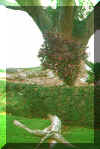
|
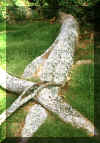 |
| The roots of this large Leguminous
tree show clear signs of Secondary Growth |
We have studied secondary growth in stems first because
of the great importance of woody stems and because of their familiarity. You will discover
that identical processes occur in roots. There is one important thing to keep in mind as
you consider roots. Remember that the procambium forms a solid core of vascular tissue in
roots. Thus a pith is generally NOT
PRESENT and xylem occupies the center of the root. There are exceptions, of course, but we will
concentrate on the most central examples before we venture into the variations.

The Stele of a Typical Dicot Root
at the end of
Primary Growth

3-D Representation of a root at
the end of
Primary Growth

If
Secondary Growth Occurs
The
Vascular Cambium remains active between the Phloem & Xylem.
It
becomes Continuous because cells of the Pericycle are recruited.

The
Vascular Cambium operates the same way as it does in Stems.
The
Secondary Xylem in the Roots of herbaceous plants usually contains a lot of Parenchyma
while that in trees resembles wood.

Ginkgo
Root (Gymnosperm)
 |

|
| Note
the Triarch Xylem organization in the primary xylem of the Image above. Locate
this in the adjacent images of Ginkgo roots. Ginkgo is a gymnosperm
which has secondary growth in its roots.
Locate the Secondary Xylem. |

Also note the presence of a Periderm. |
Medicago
(alfalfa) Root.
Secondary
xylem consists largely of parenchyma. During secondary growth, cell divisions have
occurred in parenchyma cells of the secondary xylem and primary xylem to such an extent
that the primary xylem has become somewhat disorganized, and its original position is hard
to determine. Fibers are present in both xylem and phloem.

Center of an Alfalfa Root with Secondary Growth.
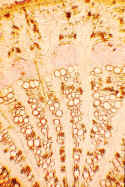
Low magnification view of Secondary Growth in Alfalfa Root. The Xylem is
obvious and has thick Rays. The Phloem is located just outside of the Xylem but is hard to
see.
|
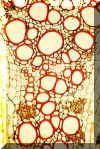
Magnified area of secondary xylem from Alfalfa. Note the large Vessel
Members, smaller Tracheary Elements Parenchyma and Fibers.
|
Secondary
Phloem in fleshy roots usually has lots of Parenchyma but it may resemble Phloem in the
Stem
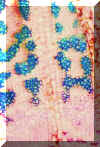
Secondary Phloem of Papaya Root stained
with Toluidine Blue.
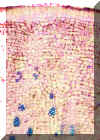
Outer Part of a Papaya Root
Locate the Periderm!!!

Secondary xylem in the
Roots of woody plants can resemble that formed in stems.
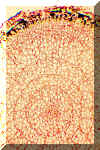

Roots can also form Periderm like that seen on the Pandanus
prop root below.
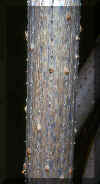
There
are no real differences in anatomy between
Periderm formed by stems or roots.


Locate the Periderm in this root. Then locate Secondary Xylem,
Vascular Cambium and Secondary Phloem!!

Top